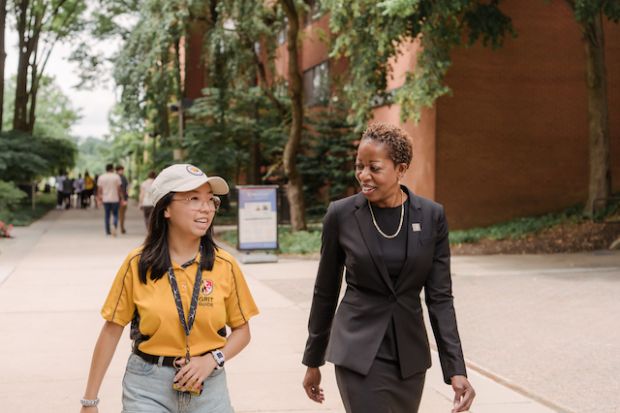One of the first priorities for Valerie Sheares Ashby in her new role as president of the University of Maryland, Baltimore County is to increase its infrastructure and staff to catch up to the immense growth the institution has experienced in recent years.
Founded in 1966 as part of the University of Maryland system, UMBC in February gained Research 1, or R1, status, the highest in the Carnegie Classification of Institutions of Higher Education, meaning it has “very high research activity”. In September, UMBC welcomed more than 2,100 first-year students, the largest incoming class in its 56-year history.
“We have grown so quickly in excellence, but our structure to support us did not grow at the same level,” said Dr Sheares Ashby, who started the job on 1 August. “People are doing multiple jobs, and because they are committed to the place, they’ve done whatever needed to be done.”
She said it was “beautiful” to see the grit and commitment of the faculty and staff that she inherited, but even that is not enough to keep up with the steep growth trajectory in research and teaching that she aims for. “We can’t do that if we don’t have the sustainable infrastructure and the right people in the right places,” she said. “This is now an area of expertise, and you have to hire for that.”
In addition to bringing in more people, Dr Sheares Ashby intends to improve support for existing staff and processes across the institution.
“I care deeply about the well-being of our people, and it’s going to burn them out if we don’t fix it,” she said.
UMBC’s R1 status puts it in the ranks alongside its Baltimore neighbour Johns Hopkins University; the Carnegie Classification deems an institution R1 if it awards at least 20 research or scholarship doctoral degrees across a range of disciplines in a year and has at least $5 million (£4.6 million) in total research expenditures. In 2021, UMBC secured $200 million in new research funding.
Dr Sheares Ashby’s predecessor, Freeman Hrabowski, a prominent higher education leader and civil rights activist, championed a mission of “inclusive excellence” during his 30-year tenure and introduced a raft of initiatives to help black and under-represented students achieve academic success. These include his flagship Meyerhoff Scholars Program, which supports outstanding minority scholars in science and engineering fields. The scheme has more than 1,400 alumni, among them Kizzmekia Corbett, whose work on mRNA coding was used in the development of Moderna’s Covid-19 vaccine.
UMBC is now the leading producer of black students who go on to complete doctoral degrees in the natural sciences and engineering in the country. More than half of students identify as non-white, and in 2020 29 per cent of students received Pell grants, federally funded need-based financial aid packages.
Taking the reins from a leader such as Dr Hrabowski would be a challenge for any new president, but Dr Sheares Ashby counts him as an influential mentor. Before she was even a department chair, Dr Hrabowski told her that she would one day become a university president. “This is so bizarre,” she said, “when I sit in that office now I think, ‘This is where I first heard those words.’”
Dr Hrabowski’s successes are what attracted Dr Sheares Ashby to her new role. “The values and the vision here don’t get any closer to who I am,” she said. However, she is eager to do things differently in order to build on what he achieved.
“[We became an R1 institution] in this very short amount of time. What does it take to be an excellent R1 institution for the next phase? That’s a different thing to what got you here. You actually can’t keep doing what got you here – it won’t take you to the next place,” she said.
In the coming months, she plans to hold 30 listening sessions with alumni, current students and members of the public from across Baltimore to hear what their vision is for the university. “They all think they own the place,” she joked, before going on to emphasise the importance of working with the wider UMBC community to chart the next path for the institution.
“It will be for us as a community to decide what that culture looks like where we are first rooted in our values of inclusive excellence, rooted in our history and excellence in innovative pedagogy; and now we’re saying we’re a leading research institution. Those things don’t naturally overlap, but we’re going to do it.”
Register to continue
Why register?
- Registration is free and only takes a moment
- Once registered, you can read 3 articles a month
- Sign up for our newsletter
Subscribe
Or subscribe for unlimited access to:
- Unlimited access to news, views, insights & reviews
- Digital editions
- Digital access to THE’s university and college rankings analysis
Already registered or a current subscriber? Login







